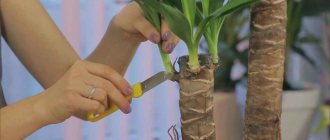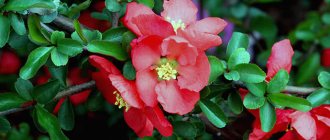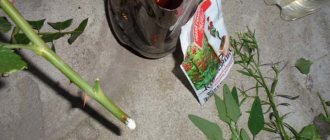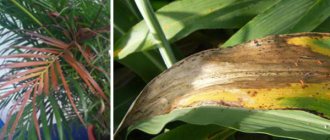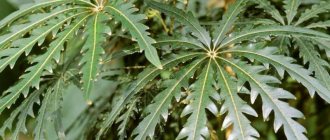Category: Care Published 08/19/2018 · Comments: · Reading time: 7 min · Views: 6,087
Spreading tropicanas are loved by gardeners for their gorgeous foliage and relative ease of care. Sooner or later, every owner of a luxurious plant wonders how to propagate a palm tree at home?
Before you start propagating a palm tree, you need to clearly understand which plant is to be propagated. After all, real palms and so-called false palms have common and different ways to obtain young plants. Among the distinctive ones there are those that can destroy a real palm tree, but are absolutely acceptable for plants similar to it.
Consequently, it is necessary to consider the methods of propagation of true palm trees from the Arecaceae, or Palmaceae, family separately from the methods of growing young plants, which are only popularly called palms.
How to grow a palm tree
Author: Galina Goncharuk February 09, 2021 Category: Indoor plants
Prices for indoor palm trees on the Internet are amazing in their diversity.
Once I looked at one of the online auctions, and there a wonderful Date Palm was being sold for 400 hryvnia. But Hamedorea is much cheaper. But the problem is that you want, as in the famous cartoon, more of everything. Therefore, the following decision would be quite logical: what we can grow with our own hands, we will propagate and grow ourselves. Not all palms are easy to grow, especially from seed. They take a long time to hatch and do not sprout the first shoots soon. But flower growers are not looking for easy ways. Growing a palm tree is not a simple process, but it is an interesting one. There are two options: from seeds and by dividing the bush.
Common varieties of domestic chamedoreas
- The most common is Hamedorea elegans - a palm tree with a bare trunk and dark green leaves. Its flowering is interesting - the branches are strewn with yellow balls.
- Hamedorea talla is not named so in vain; it reaches 2 meters in height and is not a bushy palm. The flowers of this plant are orange.
- The favorite of gardeners is Hamedorea unicolor with light leaves and yellow flowers.
- Rare species include the Arenberg variety. This palm has a single trunk with 5-6 wide leaves.
- Another valuable tree is Ernesta Augusta - luxurious, with green hair.
- The metallic variety is an unpretentious and shade-tolerant indoor palm tree. The plant is considered one of the ideal options for the home - it grows no more than 2 meters, remains green throughout the year, and maintains a dense crown. It blooms at an early age with orange-red flowers - small, reminiscent of shaggy panicles. They can hardly be called beautiful, but they smell very nice.
Whichever chamedorea you choose, they are all simply stunning. Or maybe you have rare varieties? Then we can really envy you.
How to grow a palm tree from seeds
Growing a palm tree from seeds is probably the most interesting and exciting activity that a gardener can be interested in. For example, I was very curious: whether it germinates or not. And since you need to wait for an answer for more than six months, the interest becomes stronger the further you go.
I will tell you using the example of Hamedorea seeds. But, in principle, other types of palm trees can be grown in this way. We especially like to grow date palms.
When purchasing seeds, you should immediately pay attention to the packaging and expiration dates. Because old palm seeds have very low germination rates. If they were packaged a year ago, don’t buy them; they won’t sprout.
To sow palm seeds, you can take plastic disposable cups (100-200 ml) and make holes at the bottom for drainage. We pour soil into them, consisting of leaf soil (1 part), perlite (1 part) and vermiculite (1 part). The mixture should be 1-2 cm below the edge of the cup.
Pre-soak the palm seed in water for 5 days. We clean it from the remnants of the fleshy shell. And we file down the hard coating a little using an abrasive stone or a file. All this speeds up the germination process.
We water the soil in a cup and bury the seeds of Hamedorea (or another palm tree) into the soil, one in each cup, with the sawed part down. There is no need to cover it with soil.
Then we set up a greenhouse for the seeds - we put a plastic bag on the glass. This way moisture will not evaporate from the soil. Place the cups with seeds in a warm (at least 25-27°C) and well-lit (at least 10-12 hours) place.
Now we are waiting for the seeds to germinate. We water it constantly. We ventilate once a day. And we wait. For a long time. The seeds of some palm trees take six to nine months to germinate.
When the sprouts are 2-4 cm long, transplant each one into an individual permanent pot using palm soil. For the first year, the young palm tree needs to be well shaded from direct sunlight.
Palm tree propagation by dividing the bush
Not many palm trees reproduce by branching or dividing the bush. Among the widespread ones is, for example, Hamedorea. Other types of palm trees are either impossible to propagate in this way or too troublesome.
But in the case of
Hamedorea, propagating a palm tree in this way is preferable than from seeds.
This way you will get results faster. If you have to wait about six months for a sprout to emerge from the seeds, then it will take 4-6 weeks for rooting by dividing the bush. And after 4 months you will receive a young plant. Separation of a young bush from the main one should be done during the growing season - best in May. At this time, transplantation of mature palm trees is usually carried out. So, during transplantation, you need to separate the young branch, which is located on the side. It is better to take a shoot no higher than 25 cm so that it takes root more easily. Also, a young Hamedorea bush should have flexible stems, a fully formed small branch and its own roots.
We free the roots of the adult palm tree and the shoot from the ground (so that you can see where to cut). Carefully separate the young bush using a knife, while cutting the connecting roots as close as possible to the main part of the palm tree. Sprinkle the sections with charcoal, crushed into powder.
Pour soil for palm trees or a mixture of leaf humus (2 parts), turf soil (1 part) and perlite (2 parts) into a small pot. We place the shoot there, water it and sprinkle it with soil. We also plant an adult plant, but in fresh soil.
We place the young Hamedorea for rooting in a warm place (temperature about 30-35°C). If possible, you can make a frame over the pot from thin wire and stretch a transparent bag over it to create a greenhouse. This is especially recommended if the house is not very warm even in May. If you don’t have a greenhouse, then the required humidity can be provided by constant spraying.
How to care for a palm tree at home
Many admirers of large plants deny themselves the pleasure of placing a southern beauty in their apartment because they do not know how to care for a palm tree. There is even an opinion that palm trees grow only in those houses where the owner has a “light hand”. However, the concern is unfounded; the palm tree is not difficult to maintain.
Interesting. Many owners of these plants intuitively “house” them away from other flowers, somewhere in the opposite corner of the room, this is correct. Palm trees do not like close proximity. A sense of space and a lot of air around are important to them.
They grow best in greenhouses and conservatories with high ceilings and enough space for all the flora.
Selecting a location, temperature and lighting
The intuitive habit of placing a palm tree in a bare corner makes sense, especially if it receives natural daylight through a window throughout the day. The shady side of the room, as well as an unlit corner, are unsuitable for placing a pot, since the lack of light will negatively affect the level of photosynthesis and, therefore, the color of the foliage. Some varieties of palm trees are able to live in the shade, while most simply die or stop growing.
Placement away from plants
Even in such specimens that are resistant to lack of light, the leaves become significantly dull and their size decreases.
Watering and humidity
Where the palm tree grows in its natural environment is quite humid and warm. Therefore, you need to water it so that the soil in the pot is always moist, but not waterlogged.
Attention! The condition of the soil in the pot should not resemble a swamp. If the water remains on the surface of the soil and turns into puddles, such soil is not suitable for the palm tree; the soil needs to be changed, the pot needs to be drained and equipped with a tray.
Since in the summer months the plant needs abundant watering, but at the same time is afraid of stagnation of water, you need to provide it with a container that will collect excess moisture. A deep pan is also needed so that during the heating season the water collected in it evaporates, providing moisture to the air near the palm tree.
In winter, the amount of watering should be reduced if the room becomes cool and damp. In cases where the quality of heating copes with maintaining the room temperature above +22˚C, the number of waterings should not be reduced, since the microclimate is comparable to summer values.
Important! The exceptions are Washingtonia and Brachea, for which it is important to reduce the temperature in winter to +10˚C.
The plant loves moist air; it breathes it through a large surface area of its leaves. In order for the palm tree to receive enough air and moisture from the environment, it is recommended to spray all the greenery every day. During periods when the humidity of the room turns into dampness, there is no need to additionally moisten the plant (usually this happens in spring and autumn, when the heating has not yet been turned on (or has already been turned off), and the temperature outside does not rise above +13˚C).
Soil selection
Palm trees grow well in light, breathable substrates that do not clump, which means they freely allow excess water to pass into the pan. Proper care of a palm tree at home begins with the composition of the substrate. There is no need to independently look for the components of the correct soil, measure the amount of substances and mix them. Most flower shops sell ready-made soil mixtures for palm trees. They are universal for any variety and are completely ready for use.
Attention! Before planting a palm tree in a pot, you need to cover the bottom with drainage, which will remove excess moisture from the roots.
If you want to prepare the soil for your tropical pet yourself, you can use the following composition:
- 1 part sand;
- 2 parts of fertile land;
- 1 part humus.
Fertilizer and feeding
A newly purchased palm tree does not need to be fed or replanted for the first 14 days. The plant needs adaptation to new conditions. After two weeks, you can apply fertilizers by first moistening the soil.
Palm trees love organic matter obtained from the processes of decomposition of plants, similar to the natural process that occurs in the subtropical latitudes of the mainland of South America, as well as on the islands and in the tropics, when fallen green plants cover the soil, rot and become natural fertilizer.
Many gardeners recommend soaking cow or bird droppings in large containers, keeping it for 5-7 days, filtering and fertilizing palm trees with this solution. The feeding method is effective, but what should a city dweller do who wants to feed his palm tree and does not know where to get cow dung? There is a solution.
Features of cultivation
Soil selection
When choosing a substrate for planting an exotic plant, you should pay attention to both its composition and the acidity of the environment, which should be neutral or slightly acidic. This will provide better conditions for the growth of rapeseed.
The best option would be to use purchased soil for palm trees.
For those gardeners who want to independently prepare a substrate for Asian shrubs, you can use the following ingredients: peat soil, turf soil, compost soil and river sand in a ratio of 2:2:2:1.
Location and lighting
The place for placing the pot with rapis should be well lit. In the summer, it is recommended to expose rapis outdoors, and it is necessary to place the flowerpot so that the plant is not exposed to direct sunlight, which can cause the leaves to burn.
In the summer, a balcony, veranda or flowerbed will be an excellent environment for the growth of rapeseed. It is possible that under such conditions the palm tree will even bloom, which happens extremely rarely when grown indoors.
In order for the leaves of your home palm tree to grow evenly, you should regularly rotate the pot, ensuring that the shrub is evenly illuminated by sunlight.
A plant that has been grown in a store for some time should not be immediately exposed to the sun when moved home: keep the pot in partial shade for a couple of weeks and gradually increase the light intensity.
Temperature, humidity, watering
The advantage of the bamboo palm is that the plant can quickly adapt to environmental temperature conditions. Rapis will retain its decorative properties even if it is kept at a temperature of +10°C in winter. However, in winter, it is best for rapeseed to be kept in a room with a temperature of +12...+16°C.
In summer, during the active growth phase, temperatures within +20...+25°C will allow the plant to feel as comfortable as possible. If the temperature exceeds optimal values, gardeners should regularly ventilate the room, making sure that the plant is not exposed to drafts that could harm the palm tree. It will also be necessary to ensure optimal humidity by regularly spraying the rapis with settled water and gently moistening the leaves with a cloth soaked in water.
During the summer months, you should water the shrub with plenty of water to completely wet the soil in the pot. It is also necessary to carefully ensure that the soil remains moist and does not dry out. In winter, you should water rapis less often, but you should also not allow the earthen ball to dry out.
The water used to water the bamboo palm should be soft, settled and at room temperature.
Fertilizers and fertilizers
From April to early September, rapeseed needs fertilizing, which is recommended once every 2 weeks. For these purposes, you can use complex fertilizers for palm trees. During the dormant period there is no need to feed the exotic plant.
Transfer
The process of transplanting the painting should only be carried out if the plant has become too large for the pot. This is explained by the fact that the palm tree does not tolerate annual replanting quite well, this negatively affects its growth and development. This procedure is carried out in the spring.
Please note that during transplantation it is necessary to preserve the earthen ball on the roots of the rapeseed, which will protect the root system from damage and prevent the death of the plant.
The container into which the transplant will be carried out should be wide, but not very deep. A deep pot can cause stagnation of moisture and then lead to disruption of air permeability and damage the root system of the bush.
Drainage should be provided in the new flowerpot. For this, it is recommended to use expanded clay or small crushed stone; it is better to use pebbles.
After transplantation, the bush is quarantined for 14-20 days. During this period, you should maintain optimal air humidity, spray the leaves, moisten the soil, ventilate the room and apply fertilizer.
Related article: Celery: planting and care in open ground
Also, after transplanting, gardeners are recommended to mulch the soil using sphagnum moss. This will keep the soil moist for a longer time.
Trimming
To preserve the decorative properties of the shrub, you should regularly get rid of yellowed, old and fading leaves, pruning them at ground level. After pruning, you should not water the rapis for several days, since water getting into the cut area can cause the process of rotting and cause the death of the palm tree.
Winter care
In winter, it is necessary to use steam generators that will humidify the air, which will lack moisture due to heating devices.
In winter, rapeseeds do not need to be fertilized.
To ensure a comfortable temperature for rapeseed in winter (+12...+16°C), you should keep the plant away from radiators.
You can increase the plant's daylight hours using special fluorescent lamps.
Causes of foliage damage and methods of treatment
The pride of every palm tree is its foliage. Therefore, when the appearance of the greenery deteriorates, housewives begin to analyze the situation in search of an answer to the question of why the leaves of the palm tree begin to turn yellow.
There is a biological reason that has nothing to do with disease or improper care - old leaves dry out and die, and new ones grow at the same time. This is a natural process. To maintain an attractive appearance, you can trim off a yellowing specimen.
Yellowing and drying of leaf tips
When yellow tips begin to appear on a large number of leaves, it is worth looking for the cause in the conditions under which the plant is kept. Caring for a palm tree at home should ensure that there are no drafts.
Novice gardeners often overwater tropical beauties because they are afraid of the soil drying out. Palm roots really love moisture, but at the same time they are afraid of waterlogging, so at the first appearance of yellowed tips of the foliage, you should analyze the watering regime.
Dry and trapped indoor air can ruin palm leaves. In the absence of a humidifier, it is necessary to frequently spray the foliage with soft water. Once a week, if possible, you can bathe the plant, wiping it from dust deposits that interfere with breathing.
White coating on leaves
The most common and safest reason for the appearance of white plaque on leaves is the use of hard water. Moisture from the surface evaporates, and lime or salt deposits remain and clog the pores of the plant, worsening its condition. If hard water flows in the water supply, it must be allowed to settle before watering and spraying palm trees. You will have to have a separate bucket in which there will always be tap water, from which chlorine will evaporate and impurities will settle to the bottom.
White plaque from fungus
The second reason for the appearance of white plaque on a palm tree is a fungal infection. It develops when there is excess moisture in the air, that is, when the room is cool and damp. In order to prevent infection with fungus, palm trees are not sprayed during the off-season.
Additional Information. You can get rid of an existing infection by treating with fungicides and trimming infected leaves.
Possible problems
When growing rapeseed, difficulties usually do not arise, but if the conditions for caring for the plant are violated, the grower may encounter certain problems, among which the following should be highlighted:
- the formation of brown spots on the surface of leaf blades. This occurs due to the plant being kept in dry air. You can cope with such a disease by ensuring optimal temperature conditions, as well as regularly spraying the palm tree;
- The appearance of yellow spots on the leaf plates is due to the influence of direct rays of the sun. To avoid this problem, the plant should be provided with diffused lighting;
- keeping an exotic plant at low temperatures leads to the leaves darkening and drooping: it is necessary to transfer rapis to more comfortable conditions;
- signs of damage to the root system are slow growth. If the roots were mechanically damaged during the replanting process, it is necessary to wait some time for the palm tree to take root and become stronger. If the roots suffer from the effects of a fungal disease, the plant must be urgently transplanted into a clean pot with fresh soil mixture, while pruning the affected areas and treating the roots with a fungicide.
Palm Propagation Instructions
The method of propagation of a palm tree depends on its type. Flowering species that produce seeds can be germinated naturally - from seeds and seeds. Non-flowering varieties reproduce vegetatively.
Vegetative propagation
Many flower growers want to know how a palm tree reproduces vegetatively, if it most often has only one trunk. Even such a plant can be propagated vegetatively. To do this, it is enough to cut off the upper part of the shoot, separating the bottom of the resulting cutting from the leaves. Place the shoot in a pot with fertile substrate, moisten and keep at room temperature. To speed up the rooting process, you can create a greenhouse by covering the plant with a glass jar or film. After the roots appear, the greenhouse is disassembled.
Growing from seeds or seeds
Growing a new palm tree from seeds is easy. To do this, you don’t have to wait for your neighbor’s adult plant to bloom - seeds and seeds are sold in flower shops. You can propagate a palm tree only from fresh planting material, so you should definitely pay attention to what year of packaging is indicated - if more than two years have passed, it is better to discard such a set.
How to grow a palm tree from seeds, step-by-step instructions:
- Carefully cut into the dense shell of the seed or seed without damaging the kernel.
- Place the seed material in warm water.
- Wait for the seeds to swell; to increase the percentage of germination, change the water once a day.
- Deepen the swollen seed into a fertile substrate, water it, and cover it with film.
- After the sprouts appear, the film can be removed.
Attention! Palm seeds germinate for quite a long time; there is no need to throw away the seed if it has not sprouted even in a month.
Soil mixture
The palm tree reproduces best in light, fertile substrates. For this culture, the following mixture is often made:
- 1 volume of coarse sand;
- 1 volume of fertile soil;
- 2 volumes of good humus.
River sand is best suited. At the bottom of the container you need to pour a drainage layer of red brick fragments, since excess moisture can cause rotting of the root system.
A room facing north receives little sunlight. In this case, it is advisable to install the tree right next to the window, creating a background for it from light curtains that additionally reflect light.
In the first years, the leaves of young palm trees differ from the leaves of adult plants; they are very tender. Caring for grown plants is no different from caring for adult palm trees.
Caring for a palm tree and how it reproduces depends on the type of plant. Some types of palm trees reproduce only by seeds, some can be propagated by division or daughter suckers. By following these tips, growing a beautiful palm tree will not be difficult even for an inexperienced gardener.
What to choose: pot or tub
It is preferable to take a pot for a palm tree, as for other plants, from natural materials. Such a container will allow the roots to breathe and will not create conditions for rot to occur.
Additional Information. If you have already purchased a pot and it is plastic, you should not get rid of it, because you can transplant a palm tree into it. In this case, you will have to regularly loosen the soil, providing air exchange for the roots, in order to avoid encounters with the fungus.
A large wooden tub is perfect for an adult plant; you can plant a perennial palm tree in it, which is cramped in its previous place. However, transplantation of young plants should take place in containers corresponding to the size of the root system.
Having a palm tree in your room is not only beautiful, but also useful. It perfectly renews the composition of the air, enriching it with oxygen; its appearance reminds of relaxation and complete absence of worries. Some types of bush-like palms can be planted in several pots and get a tropical forest, which will give the interior a fresh look and inform the owners with its appearance if the air in the room begins to dry out.
Propagation by seeds
How does an indoor palm tree reproduce by seeds? reproduce by seeds , and Howea, Washingtonia, Likuala, Trachycarpus and Livistona - only by seeds.
The longer they are stored, the less likely they are to wait for germination; be sure to read the labeling and do not buy seeds that have passed their expiration date.
Seed preparation
Be sure to free the seeds from the outer shells, if any, and place them in warm water for several days to swell .
The place for the container with seeds should be warm, up to 30 degrees, the water can be changed. If the seed skin is very strong, it should be sawed off with a rasp, but very carefully, without damaging the seed itself.
Sowing
are suitable for sowing , but if the seeds are large, you need to choose a larger container; if it is a coconut, do not forget to place it on the side seam, this will speed up germination.
Fill the prepared containers with a substrate of garden soil and sand in a 2:1 ratio, the top layer should be sandy, and sow the seeds to a depth of 2 or 3 centimeters.
Sandy soil is washed away when watering; to avoid this, you should use a sprayer . The containers need to be covered with polyethylene; with its help, a greenhouse effect is created, which is so necessary for plants during germination.
When the seedlings appear , place them in a more luminous place, but avoid direct sunlight, at this stage of development this is very harmful. The grown shoots from the box need to be picked into individual temporary pots with the same substrate; after picking, be sure to cover the plants with plastic bags or glass jars, this way they will take root faster, since there is practically no evaporation.
Over time, gradually free young plants from film coverings , let them adapt to the climate of the room and grow before transplanting to a permanent place.
Vegetative propagation
The majority of palm species do not branch, forming only one stem, but there are exceptions, and they are mostly grown indoors.
Such palms are called bush palms , of which the most common are Hamedorea, Robelena date, Caryota, Hamerops, and Chrysalidocarpus. They can be propagated by root suckers.
Offspring
On the roots, which are located close to the soil surface, root suckers are formed, taking root, they form an independent plant. Wait for the palm shoot to take root, and using a sharp knife, separate the young plant from the mother bush, sprinkle the cut area with ash.
The offspring is already quite developed and can be planted in a permanent place, but it should be watered properly.
Tops
The palm tree itself cannot reproduce in this way, but there are plants very similar to them that are very easily propagated vegetatively.
Most often, dracaena and yucca are grown in our homes. To separate the top, use a sharp knife or a small garden hacksaw; it is necessary to leave a section of the stem to be buried in the substrate. There is no need to dig in the leaves; most likely they will rot and will need to be removed, since the survival rate of dracaena and yucca is 90%. You can plant the plant in a permanent place; the soil composition for all plants of this type is the same - 2 parts humus, 1 part garden soil, 1 part sand.
Don't forget to cover the top of the pot with a plastic bag to ensure a greenhouse effect. When the rooted plant produces young leaves at the top, the bag can be removed.
The cut site does not need to be covered or sprinkled, nature has provided such nuances, the self-healing process begins immediately, and young shoots sprout abundantly from the buds located below the cut.
By shoots
The shoots do not have their own roots, but they are easily formed when planted in the ground; it is necessary to very carefully separate them from the mother plant and plant them for rooting with further planting in a permanent place, or even immediately in a permanent place. Don't forget to create a greenhouse effect.
Cuttings
The stem without a top can be divided into cuttings of 15 or 20 centimeters and placed in water until roots form, and then planted in a permanent place. You can immediately plant the cuttings in the substrate, water it properly and cover it with a plastic bag until rooting is complete.
The soil
The palm tree grows well on rich, light soils, and most often the following composition : 2 parts humus, 1 part garden soil, 1 part sand, it is advisable to use river sand, but despite the good water conductivity of this type of soil, it is necessary to put it on the bottom of the pot place a drainage made of broken red brick, and make sure there is a hole in the bottom of the pot; excess stagnant water will lead to rotting of the roots and the inevitable death of the plant.
If you find an error, please select a piece of text and press Ctrl+Enter.
- Author: Maria Sukhorukikh
Rate this article:
- 5
- 4
- 3
- 2
- 1
(0 votes, average: 0 out of 5)
Share with your friends!
Choosing a pot
First of all, the pot must be suitable for the plant in size; there is no need to buy pots for growth; as it grows, it is transplanted into a larger container; besides, your taste may change by this time.
A ceramic pot is ideal for all types of indoor plants , the palm tree is no exception, it is environmentally friendly, it itself regulates the water and air balance of the root system.
They also live in plastic containers and pots , but it is necessary to loosen the soil more often and arrange more reliable drainage. All kinds of wooden containers are good for palm trees, they well emphasize the decorative nature of the palm tree, but they themselves require care when in contact with water; it is easier to use them as flowerpots.
